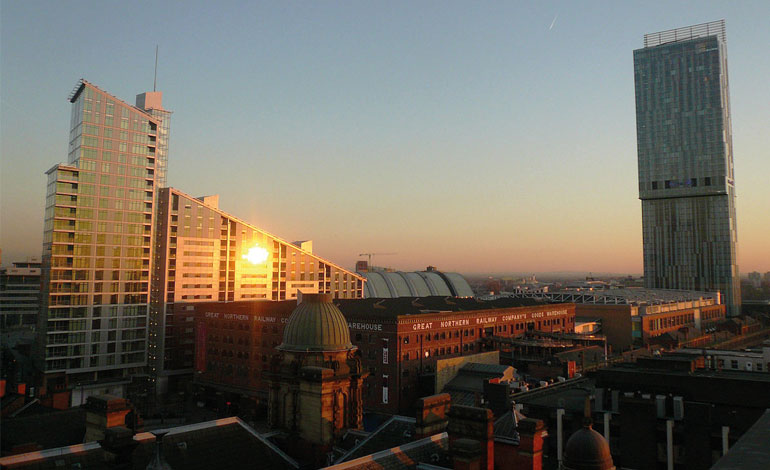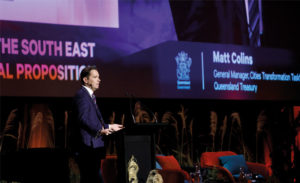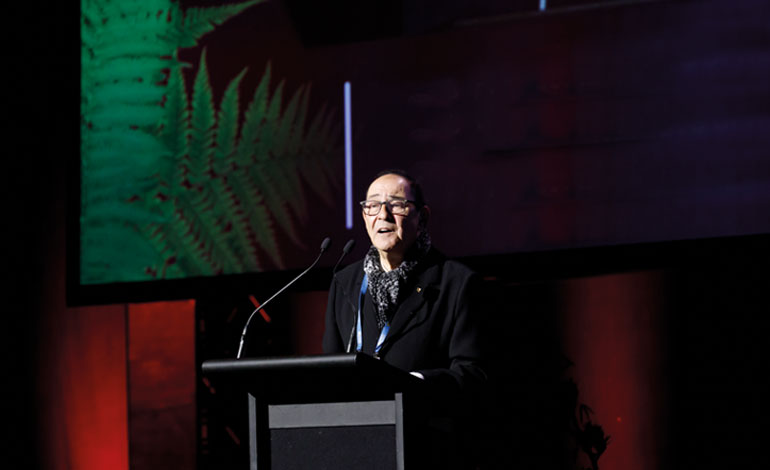In the UK and Australia, local bodies are negotiating with central government for bespoke packages of funding and decision-making powers.
Sir Howard Bernstein, the architect of Greater Manchester’s ground-breaking 2012 city deal, visited our country recently for Infrastructure New Zealand’s Building Nations Symposium 2019 in Rotorua. Sir Howard spoke with LG magazine after the symposium.
Sir Howard Bernstein’s achievements are the stuff of local government legend in the UK. He’s one of the chief architects of Manchester’s renaissance over the past four decades. From a grubby depressed city to a flourishing centre for business, study, enterprise and culture, the city’s reputation soared under his watch.
Much of Manchester’s success stems from Sir Howard’s use of ‘city deals’: a mechanism enacted in 2012 by the cash-strapped UK central government to promote infrastructure and economic growth. Brokered on a case-by-case basis, the city deals ultimately shift decision-making away from central government to local bodies, enterprises and communities.
A string of credits is attached to Sir Howard’s time as chief executive of Manchester City Council (1998 to 2017) and as head of paid service for the Greater Manchester Combined Authority (2011 to 2017).
Knighted in 2003 for his services to that vast northern English city, Sir Howard has since become a strategic advisor through Deloitte UK to public, private and academic institutions in the UK and internationally. There he specialises in health and social care, government reform and devolution, and regeneration.
Sir Howard is widely credited with spearheading the rebirth of Manchester following the June 1996 Provisional Irish Republican Army (IRA) bombing in which 220 people were injured but, miraculously, nobody killed. Left in a white van outside Marks & Spencer in the city hub, an almost 1500-kilogram device devastated the nearby Arndale Centre packed with shoppers.
Given a one-hour warning, authorities had managed to evacuate 80,000 people from the area. Afterwards they told stories of having to persuade people to leave. Some workmen were reluctant to give up on the possibility of overtime pay. Other people wanted to finish eating their pizza.
When the bomb went off, the blast could be heard 24 kilometres away. Its force knocked people to the ground and blew out virtually every window within almost a kilometre. In the resulting confusion, shop mannequins were briefly mistaken for people.
The events of June 15, 1996 have been called some of the darkest and most defining moments of the city’s history.
It is true that some moves to help lift the city from the doldrums were already afoot. Manchester had already won the bid to host the 2002 Commonwealth Games. A tram network had been reintroduced a few years before and some cultural venues were on the cards.
But the bombing triggered a remarkable city renaissance that was escalated when Sir Howard took up the reins two years later as Manchester City Council’s chief executive. His tenure saw billions of pounds worth of international investment flood into the area and a devolution agenda that has re-shaped the UK constitution.
A wave of deals
For many people, Sir Howard is best known for his city deal initiative for Greater Manchester. It was part of a bunch of such deals completed in July 2012 covering the eight largest English cities outside London. (For more on Manchester’s renaissance see the box story Have I got a deal for you.)
A UK Cabinet Office publication Unlocking Growth in Cities: City Deals – Wave 1 said the first wave of deals could create 175,000 jobs over the following 20 years and 37,000 new apprenticeships.
A second wave of English city deals was finalised in July 2014. Subsequently, the model was rolled out in Scotland and Wales. By 2018, a total of 33 deals had either been agreed or were planned. Earlier this year, Belfast become the first city in Northern Ireland to get the green light for a deal.
Such opportunities had arisen when the 2011 Localism Act, which included the Core Cities Amendment, offered local councils the opportunity to submit plans on how they would promote local economic growth. Successful councils were invited to negotiate deals with central government for greater local autonomy over financial and planning matters.
The underpinning idea was to shift thinking away from “a one-size-fits-all model” towards structures that work best for the specific needs of an individual city or group of cities.
In March 2017, the Australian Government announced it would begin modelling city deals along similar lines to those used in the UK. (See Dealing Aussie style.)
When Sir Howard visited New Zealand recently for Infrastructure New Zealand’s Building Nations Symposium 2019, he presented a keynote speech, ran a ‘deep dive’ focus session with a small number of participants and joined other panellists to debate critical success factors in city deals.
Local Government Magazine spoke with him after the conference to gauge his ideas on what city deals could mean for this country. This is a redacted version of the conversation.
Have I got a deal for you
When in 2011, 10 local government authorities combined to create the Greater Manchester Combined Authority (GMCA) they started a process that would transform the powers of councils, people and businesses in the area.
Local Enterprise Partnerships (LEPs) got behind the movement. A group of key stakeholders from government, business and the community, these LEPs were based on logical economic regions.
Together, they were lining up to sign what became a “compelling platform for radical devolution of powers from central government”.
The July 2012 city deal agreement outlined an eight-part pact detailing commitments on the parts of the GMCA and central government.
In summary, the Greater Manchester City Deal would:
• Create a revolving Infrastructure Fund by allowing Greater Manchester to ‘earn back’ a portion of additional tax revenue from Gross Value Added (GVA) increases resulting from local investment in infrastructure.
• Establish a Greater Manchester Investment Framework to align core economic development funds.
• Create a City Apprenticeship and Skills Hub to place apprentices with SMEs, as well as piloting a skills tax incentive and locally determined outcome payments to providers.
• Strengthen Greater Manchester’s Business Growth Hub, which integrates trade, investment and businesses advice.
• Develop Manchester’s role as a beacon for high value inward investment.
• Establish a Low Carbon Hub, with a plan to reduce emissions by 48 percent by 2020.
• Establish a housing investment fund to use local and national investment to develop new housing.
• Work with the Department for Transport on a broad package of transport proposals encompassing devolution of the Northern Rail franchise, bus improvement measures and devolution of local transport funding.
Since then, much has been said and done. Sir Howard Bernstein, who became the city deal’s de facto champion, helped broker Manchester City Football Club’s investment in east Manchester, championed the Metrolink, pushed for Manchester University to merge with the Manchester Institute of Science and Technology, and much more besides.
He sees city deals as iterative processes: never finished and about much more than each deal in isolation. Seven years after the initial deal was signed, there’s a radically different vibe in the once run-down city of Manchester. ν
What do you think is the level of appetite here for city deals?
I think there’s enormous appetite for the concept of city deals. What’s important to try and understand, though, is what the purpose of city deals actually is and how it’s viewed here. Where I come from, we saw city deals as a platform for not just driving new partnership arrangements between different forms of local and central government but also to address a much stronger place-based approach to the way in which public services were funded, designed and delivered.
That was the original concept as it was identified in Manchester and Greater Manchester. If you look at the development of a number of city deals that were agreed in the UK, you see a steady stream of arrangements which, yes, included transport but also included housing, skills, employment, health, and social care. There was a whole variety of important programmes which are designed not just for individual places to improve their productivity and economic competitiveness, but also to ensure that all the residents who lived in Greater Manchester were able to share in its future success.
Do city deals have the power to help change the role of local authorities? ie from being the providers of services to being brokers, connectors and influencers in their communities?
Yes, and more importantly to become commissioners of services in the interests of people who live in their areas. That was our concept and overall strategic approach.
I appreciate you were only here for a short time, but you were in a very well-connected room. Did you get any sense of people looking at city deals in New Zealand in a similar light?
If I’m being honest, I think people so far have tended to look at city deals largely as a platform for delivering transport improvements – which is a perfectly legitimate way of doing it. I think people like me look at it in a wider setting.
The same thing probably applies in Australia as well, where I am now. They’ve looked at city deals – a perfectly rational and legitimate way to do so, I hasten to add – as a mechanism for driving transport investments.
Some people have commented that the Provincial Growth Fund is the closest thing we have here to the city deals mechanism. Did you get a sense of what extent the fund could fulfil the same function as city deals?
Maybe it could. You certainly had government ministers openly talking about the prospects of city deals as a mechanism for driving infrastructure investment. It’s very difficult to say if situations are completely linked: ie if you should be trying to replicate in New Zealand, or indeed anywhere else, what we did in the UK.
If you’re looking to create inclusive, competitive growth plans, you need to place as much emphasis on people as you do on infrastructure.
Are there any small practical steps that you would recommend for local authorities wanting to connect more to their communities?
What I think is required is a much stronger emphasis by national and local governments on place and people.
You look at city renaissance now as part of your role with Deloitte. Could a city rise again without help from central government?
No. You’ve got to look at the powers and functions of local authorities – as we describe them. What we see are lots of local authorities, and lots of functions split either between local authorities and the state or national government. If we are going to join up the dots, and wrap around public services to support people, inevitably there have to be very clear partnership arrangements between different tiers.
Local authorities can certainly set a leadership role by ensuring their funds and their programmes around place are clearly articulated. This can start to address how they – working with others – can make significant improvements in the interests of the people who live and work there.
If you had your time again, what would you do differently for Manchester?
Nothing at all. I’d just try and do it earlier and quicker.
South East Queensland – A deal in the making
Matt Collins is keen to make it clear that every city, or regional, deal in Australia is different. “They are place-based,” he says. Matt is general manager of Queensland Treasury’s Cities Transformation Taskforce. He was speaking at the recent Infrastructure New Zealand Building Nations Symposium.
There’s a bit of clue in the varying amount of dollars the Australian Government is stumping up for some of the deals already signed. Adelaide, Geelong and Townsville get AUD$174 million, $183 million and $380 million respectively. Meanwhile, Hobart receives $1.1 billion and Western Sydney a whopping $11.7 billion. (All these values are in Australian dollars.) Mind that this is just Australian Commonwealth money. There’s more flowing in from other sources. The Townsville initiative, for example, is getting $515 million from the Queensland State Government.
Nor is it about population numbers. There’s a similar number of people living in Townsville and Hobart but there’s a huge chasm between the $380 million contribution to Townsville and the $1.1 billion proffered to Hobart.
So, it’s all about the contents of the deals. And, as Matt knows, they’re like chalk and cheese.
Western Sydney is homing in on seven focus areas. These include passenger rail, a Development Authority and Investment Attraction Office, and the magnificently named Aerotropolis.
Geelong wants its money to go into a convention and exhibition centre, Great Ocean Road infrastructure, a Shipwreck Coast master plan and revitalising the central township.
Meanwhile, over in South East Queensland (SEQ) moves are afoot to launch yet another deal. For the past five years a bevy of folk have been working on a blueprint for a SEQ city deal.
Players include the Queensland Government and the Council of Mayors SEQ, university leaders, civic leaders and people from the private sector.
They have come up with 35 projects spread across six thematic areas. Matt says the emphasis is not just on projects but on policy alignment and reform opportunities as well.
Big-picture thinking includes supporting a ‘45-minute region’ by delivering the new rail and metro/busway projects to connect the area’s main activity and growth centres.
Another theme is around supercharging a new trade and enterprise ‘spine’: a key economic arc spanning a trade gateway in the east of the area, an area of growth in the region’s south west, and the Western Trade Gateway.
With South East Queensland’s population set to increase from 3.5 million to 5.4 million in the next 25 years, there’s a pressing need to align housing and labour markets if anyone is to stand a chance of a decent lifestyle.
Matt reckons there will be a deal signing ceremony in the middle of next year. Implementation will follow swiftly on its heels.
Dealing Aussie style
Over the Tasman, the three tiers of government – federal, state or territory, and local – have been busy sorting city deals with local communities for a few years now. The first such deal, a 15-year commitment for Townsville, Queensland, was signed in December 2016.
The deal between the governments of Australia and Queensland, and the Townsville City Council set up a collective programme of planning, reform and investment. Its three overarching aims are to make Townsville: the economic gateway to Asia and Northern Australia by 2030; a global leader in tropical and marine research and innovation; and a prosperous and highly liveable city for residents and visitors.
Stimulating job creation, economic growth, investment in local infrastructure (particularly in the city and waterfront areas) and revitalising the urban centre are all on the agenda.
A 2018 progress report lists as achievements to date:
• The launch of the Townsville Smart City Plan – Smart Townsville.
• Commencement of construction on Stage 1 of the Haughton Pipeline, delivery of the Final Report of the Townsville Water Security Taskforce, and funding secured for Stage 2 of the Haughton Pipeline subject to the outcomes of a business case assessment.
• Funding confirmed for the Port of Townsville Channel Capacity Upgrade, giving construction of the AUS$193 million (around NZ$205 million) project the green light.
• Establishment of the Townsville Industrial Development Board and acceleration of the State Development Area to explore opportunities for new industrial development.
• Funding confirmed for the preservation of the Townsville Eastern Access Railway Corridor.
Since the Townsville deal, a further six city deals have been set up in Launceston, Western Sydney, Darwin, Hobart, Geelong and Adelaide.
City deals for Perth and South East Queensland have also been announced. (See the box story South East Queensland: A deal in the making for more details.)
The Australian Government is also upscaling the city deal idea and working on a couple of pilot regional deals. Like the city deals, they will bring together all levels of government to deliver agreed outcomes in a region.
So far, three are on the drawing board. The first one likely to be finalised is the Barkly Regional Deal which covers the Tennant Creek region in the Northern Territory. Negotiation of the Hinkler Regional Deal, covering the Bundaberg and Hervey Bay region in Queensland, is underway. A regional deal for Albury Wodonga was announced in March this year.
This article was first published in the October 2019 issue of NZ Local Government Magazine.



